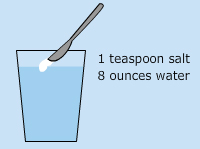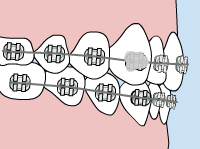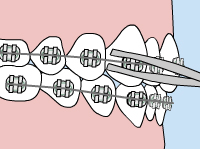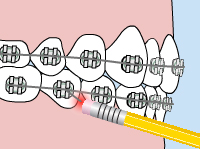Now that you have your braces, how do you take care of them? It's important for you to know how to properly take care of your braces throughout your entire orthodontic treatment.
Eating with Braces
Don't worry, you'll be eating popcorn and snacking on potato chips again in no time! However, before you can start enjoying some of the treats you love, you will need to take special care to avoid any foods that could damage your new appliances.
Foods to avoid with braces:
- Chewy foods — bagels, licorice
- Crunchy foods — popcorn, chips, ice
- Sticky foods — caramel candies, chewing gum
- Hard foods — nuts, hard candies
- Foods that require biting into — corn on the cob, apples, carrots
Foods you CAN eat with braces:
- Dairy — soft cheese, pudding, milk-based drinks
- Breads — soft tortillas, pancakes, muffins without nuts
- Grains — pasta, soft cooked rice
- Meats/poultry — soft cooked chicken, meatballs, lunch meats
- Seafood — tuna, salmon, crab cakes
- Vegetables — mashed potatoes, steamed spinach, beans
- Fruits — applesauce, bananas, fruit juice
- Treats — ice cream without nuts, milkshakes, Jell-O, soft cake

General soreness
When you get your braces on, you may feel general soreness in your mouth, and teeth may be tender to biting pressures for three to five days. Stick to a soft diet until your teeth do not hurt to chewing. Irritated gums and other sore spots can be relieved by rinsing your mouth with a warm salt-water mouthwash. Dissolve one teaspoonful of salt in eight ounces of warm water, and rinse your mouth vigorously. An alternative (and better-tasting) mouthwash is the Healthy Gums Rinse by The Natural Dentist or Peroxyl. Placing Orabase on the affected area may also help relieve discomfort; Orabase can be found in a pharmacy. If the tenderness is severe, take Acetaminophen (Tylenol®) or whatever you normally take for headache or similar pain. Aspirin, Ibuprofen (Motrin®, Advil) and Naproxen Sodium (Naprosyn, Anaprox) actually slow the tooth movement, so it is not advisable to use them frequently while wearing braces.
The lips, cheeks, and tongue may become irritated for one to two weeks as they learn a new posture and become accustomed to the surface of the braces. You can put wax on the braces to lessen this. We'll show you how!
Loose Teeth
If your teeth begin feeling a little loose, don't worry; this is normal! Your braces must first loosen your teeth to move them into the right position. Once your teeth have been repositioned, they will no longer be loose.
Take Care of Your Appliances
Damaged appliances can increase the length of your treatment process, so be sure to take care of all your appliances. Your teeth and jaw can only move into their correct positions if you consistently wear the rubber bands, headgear, retainer, or other appliances prescribed by your doctor.

Loose bracket
If your bracket or band is still attached to the wire, you should leave it in place and put wax on it if needed for comfort. If the bracket or band can be removed easily, place it in an envelope and save it to bring to your next appointment.

Loose wire
Using a pair of tweezers or needle-nosed pliers, try to put your wire back into place. It is okay to use a piece of floss to tie the wire into place: tie the floss around the bracket in place of the missing colored o-ring. If you cannot put the wire into a comfortable position, and covering the end with wax doesn't help, as a last resort use a small fingernail clipper to clip the wire behind the last tooth to which it is securely fastened. If the end of the wire is still sharp, place wax on it.

Poking wire or appliance
Using a pencil eraser, push the poking wire down or place wax on it so that it is no longer poking. Long wires can usually be clipped with a clean, sturdy pair of nail clippers or cuticle clippers.






